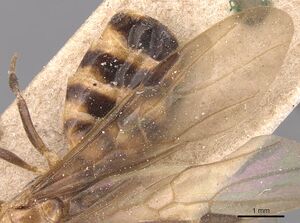Azteca fasciata
| Azteca fasciata | |
|---|---|

| |
| Scientific classification | |
| Kingdom: | Animalia |
| Phylum: | Arthropoda |
| Class: | Insecta |
| Order: | Hymenoptera |
| Family: | Formicidae |
| Subfamily: | Dolichoderinae |
| Tribe: | Leptomyrmecini |
| Genus: | Azteca |
| Species: | A. fasciata |
| Binomial name | |
| Azteca fasciata Emery, 1893 | |
| Subspecies | |
| |
Azteca fasciata is a generalist, foraging arborealy and on the ground.
| At a Glance | • Bamboo Specialist |
Identification
Distribution
Distribution based on Regional Taxon Lists
Neotropical Region: Bolivia (type locality), Brazil.
Distribution based on AntMaps
Distribution based on AntWeb specimens
Check data from AntWeb
Countries Occupied
| Number of countries occupied by this species based on AntWiki Regional Taxon Lists. In general, fewer countries occupied indicates a narrower range, while more countries indicates a more widespread species. |

|
Estimated Abundance
| Relative abundance based on number of AntMaps records per species (this species within the purple bar). Fewer records (to the left) indicates a less abundant/encountered species while more records (to the right) indicates more abundant/encountered species. |

|
Biology
|
Leite et al. (2013) studied the foraging behavior of Celeus obrieni (Kaempfer's Woodpecker), a bamboo specialists that feeds on ants. This field study was conducted in central-western Brazil on the plains of the Araguiai River from 2008-2010. The research focused on foraging by C. obrieni on Guadua paniculata, a large bamboo species, in cerradão habitat. Celeus obrieni are known to forage and breed in patches of G. paniculata. Ants use the hollow stems of the bamboo as a nesting resource.
Leite et al. found the woodpeckers, in comparison with standardized foraging observations on other plants around these same sites, concentrated their foraging on bamboo. A sample of stems (n = 900) that were not visited by the woodpecker showed ~40% contained ant nests. Thirteen ant species were found, with three being common (76% of all nests): Azteca fasciata, Camponotus atriceps, and Camponotus depressus. Most nests for these were located 2-4 m from the ground. Dead stems (59%) contained more nests than live stems. A second set of bamboo stem samples, those foraged on and drilled into by C. obrieni, were also inspected. Drilling was concentrated at the same height where the majority of ant nests were found in the unforaged-stem samples. Despite the much larger proportion of live stems within each stand, more dead (62%) than live stems were drilled. Fifty-nine percent of the drilled stems contained ant colonies. Nests of Camponotus depressus were the most common, Azteca fasciata less frequent, and Camponotus atriceps found in only four of the drilled stems.
Castes
Images from AntWeb

| |
| Syntype of Azteca fasciata. Queen (alate/dealate). Specimen code casent0905094. Photographer Will Ericson, uploaded by California Academy of Sciences. | Owned by MSNG, Genoa, Italy. |
Nomenclature
The following information is derived from Barry Bolton's Online Catalogue of the Ants of the World.
- fasciata. Azteca fasciata Emery, 1893b: 143, pl. 2, figs. 83, 84 (q.) BOLIVIA.
- Type-material: holotype queen.
- Type-locality: Bolivia: Chiquitos (no collector’s name).
- Type-depository: MSNG.
- Emery, 1896c: 6 (w.).
- Status as species: Emery, 1896c: 6; Forel, 1899c: 122; Emery, 1913a: 33; Mann, 1916: 472; Borgmeier, 1923: 92; Wheeler, W.M. 1942: 227; Kempf, 1972a: 31; Shattuck, 1994: 17; Bolton, 1995b: 78.
- Distribution: Bolivia, Brazil.
- Current subspecies: nominal plus similis.
Description
References
- Albuquerque, E., Prado, L., Andrade-Silva, J., Siqueira, E., Sampaio, K., Alves, D., Brandão, C., Andrade, P., Feitosa, R., Koch, E., Delabie, J., Fernandes, I., Baccaro, F., Souza, J., Almeida, R., Silva, R. 2021. Ants of the State of Pará, Brazil: a historical and comprehensive dataset of a key biodiversity hotspot in the Amazon Basin. Zootaxa 5001, 1–83 (doi:10.11646/zootaxa.5001.1.1).
- Emery, C. 1893l. Studio monografico sul genere Azteca Forel. Mem. R. Accad. Sci. Ist. Bologna (5)3:119-152 (page 143, pl. 2, figs. 83, 84 queen described)
- Emery, C. 1896b. Alcune forme nuove del genere Azteca For. e note biologiche. Boll. Mus. Zool. Anat. Comp. R. Univ. Torino 11(2 230: 1-7 (page 6, worker described)
- Franco, W., Ladino, N., Delabie, J.H.C., Dejean, A., Orivel, J., Fichaux, M., Groc, S., Leponce, M., Feitosa, R.M. 2019. First checklist of the ants (Hymenoptera: Formicidae) of French Guiana. Zootaxa 4674, 509–543 (doi:10.11646/zootaxa.4674.5.2).
- Leite, G.A., Pinheiro, R.T. et al. 2013. Foraging behavior of Kaempfer's Woodpecker (Celeus obrieni), a bamboo specialist. The Condor 115:221-229. doi:10.1525/cond.2013.120062
References based on Global Ant Biodiversity Informatics
- Arruda F. V., M. A. Pesquero, D. G. Marcelino, G. A. Leiter, J. H. C. Delabie, and R. Fagundes. 2015. Size and condition of bamboo as structural factors behind the vertical stratification of the bamboo-nesting ant community. Insectes Sociaux DOI 10.1007/s00040-015-0440-4
- Emery C. 1896. Alcune forme nuove del genere Azteca For. e note biologiche. Bollettino dei Musei di Zoologia ed Anatomia Comparata della Reale Università di Torino 11(230): 1-7.
- Emery C. 1913. Hymenoptera. Fam. Formicidae. Subfam. Dolichoderinae. Genera Insectorum 137: 1-50.
- Fernández, F. and S. Sendoya. 2004. Lista de las hormigas neotropicales. Biota Colombiana Volume 5, Number 1.
- Franco W., N. Ladino, J. H. C. Delabie, A. Dejean, J. Orivel, M. Fichaux, S. Groc, M. Leponce, and R. M. Feitosa. 2019. First checklist of the ants (Hymenoptera: Formicidae) of French Guiana. Zootaxa 4674(5): 509-543.
- Kusnezov N. 1953. La fauna mirmecológica de Bolivia. Folia Universitaria. Cochabamba 6: 211-229.

